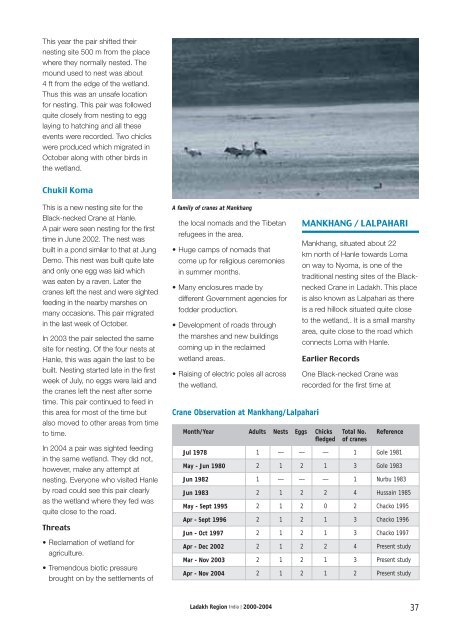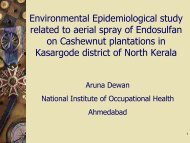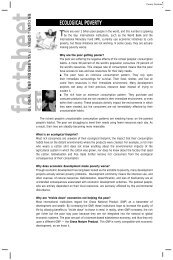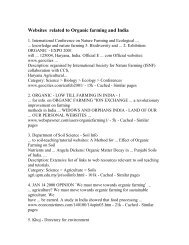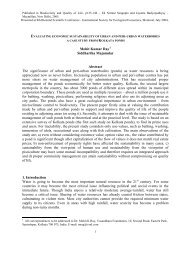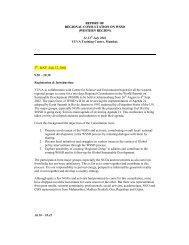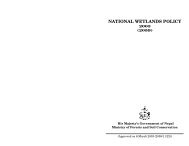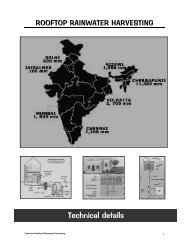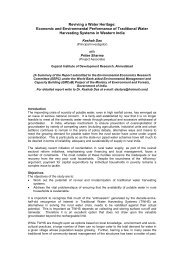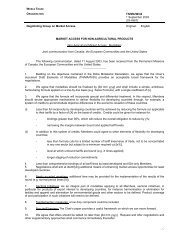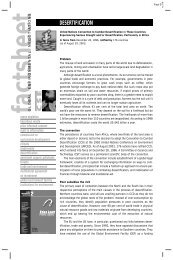Black-necked Crane - WWF-India
Black-necked Crane - WWF-India
Black-necked Crane - WWF-India
You also want an ePaper? Increase the reach of your titles
YUMPU automatically turns print PDFs into web optimized ePapers that Google loves.
This year the pair shifted their<br />
nesting site 500 m from the place<br />
where they normally nested. The<br />
mound used to nest was about<br />
4 ft from the edge of the wetland.<br />
Thus this was an unsafe location<br />
for nesting. This pair was followed<br />
quite closely from nesting to egg<br />
laying to hatching and all these<br />
events were recorded. Two chicks<br />
were produced which migrated in<br />
October along with other birds in<br />
the wetland.<br />
Chukil Koma<br />
This is a new nesting site for the<br />
<strong>Black</strong>-<strong>necked</strong> <strong>Crane</strong> at Hanle.<br />
A pair were seen nesting for the fi rst<br />
time in June 2002. The nest was<br />
built in a pond similar to that at Jung<br />
Demo. This nest was built quite late<br />
and only one egg was laid which<br />
was eaten by a raven. Later the<br />
cranes left the nest and were sighted<br />
feeding in the nearby marshes on<br />
many occasions. This pair migrated<br />
in the last week of October.<br />
In 2003 the pair selected the same<br />
site for nesting. Of the four nests at<br />
Hanle, this was again the last to be<br />
built. Nesting started late in the fi rst<br />
week of July, no eggs were laid and<br />
the cranes left the nest after some<br />
time. This pair continued to feed in<br />
this area for most of the time but<br />
also moved to other areas from time<br />
to time.<br />
In 2004 a pair was sighted feeding<br />
in the same wetland. They did not,<br />
however, make any attempt at<br />
nesting. Everyone who visited Hanle<br />
by road could see this pair clearly<br />
as the wetland where they fed was<br />
quite close to the road.<br />
Threats<br />
• Reclamation of wetland for<br />
agriculture.<br />
• Tremendous biotic pressure<br />
brought on by the settlements of<br />
A family of cranes at Mankhang<br />
the local nomads and the Tibetan<br />
refugees in the area.<br />
• Huge camps of nomads that<br />
come up for religious ceremonies<br />
in summer months.<br />
• Many enclosures made by<br />
different Government agencies for<br />
fodder production.<br />
• Development of roads through<br />
the marshes and new buildings<br />
coming up in the reclaimed<br />
wetland areas.<br />
• Raising of electric poles all across<br />
the wetland.<br />
<strong>Crane</strong> Observation at Mankhang/Lalpahari<br />
MANKHANG / LALPAHARI<br />
Mankhang, situated about 22<br />
km north of Hanle towards Loma<br />
on way to Nyoma, is one of the<br />
traditional nesting sites of the <strong>Black</strong><strong>necked</strong><br />
<strong>Crane</strong> in Ladakh. This place<br />
is also known as Lalpahari as there<br />
is a red hillock situated quite close<br />
to the wetland,. It is a small marshy<br />
area, quite close to the road which<br />
connects Loma with Hanle.<br />
Earlier Records<br />
Month/Year Adults Nests Eggs Chicks<br />
fledged<br />
One <strong>Black</strong>-<strong>necked</strong> <strong>Crane</strong> was<br />
recorded for the fi rst time at<br />
Total No.<br />
of cranes<br />
Reference<br />
Jul 1978 1 — — — 1 Gole 1981<br />
May - Jun 1980 2 1 2 1 3 Gole 1983<br />
Jun 1982 1 — — — 1 Nurbu 1983<br />
Jun 1983 2 1 2 2 4 Hussain 1985<br />
May - Sept 1995 2 1 2 0 2 Chacko 1995<br />
Apr - Sept 1996 2 1 2 1 3 Chacko 1996<br />
Jun - Oct 1997 2 1 2 1 3 Chacko 1997<br />
Apr - Dec 2002 2 1 2 2 4 Present study<br />
Mar - Nov 2003 2 1 2 1 3 Present study<br />
Apr - Nov 2004 2 1 2 1 2 Present study<br />
Ladakh Region <strong>India</strong> | 2000-2004 37


